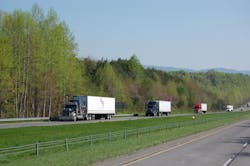FTR: Regulatory initiatives remain biggest headwind for trucking
Decent U.S. gross domestic product (GDP) growth of 2.8% in the third quarter, a 3% overall rise in freight volumes this year, minimal increases in trucking costs, and three years of relatively stable – though high – diesel fuel prices may be all outweighed by the impact of a series of regulatory efforts should they all come to pass in the near future.
That’s the conclusion the consultants with FTR Transportation Intelligence shared with reporters during the firm’s quarterly State of Freight webinar this week.
“The big deal of course is the regulatory situation,” explained Noel Perry, FTR’s senior consultant and president of research firm Transportation Fundamentals. “The FMCSA [Federal Motor Carrier Safety Administration] keeps adding more requirements to the industry, and while their impact won’t be as bad as projected in 2014 and maybe 2015, it will probably be quite bad or even worse in terms of the impact on industry productivity long term.”
The FMCSA is already being urged by the National Transportation Safety Board (NTSB) to step up the pace of its regulatory efforts, even as the trucking industry continues to deal with productivity losses engendered by changes made to hours of service (HOS) back in July.
Yet it is the potential regulatory avalanche now facing trucking – a total of some 26 potential initiatives in all – that could really clip the industry’s wings, FTR’s Perry said.
“We are easily facing the largest collection of regulatory changes in the history of this industry, from ELDs to mandatory speed limits and safety fitness ratings,” he noted at FTR’s annual freight conference back in September. “Hours of service (HOS) reform has been the single biggest shock to the system, reducing trucking productivity by 3% nationwide.”
Based on the current pace of regulatory efforts, Perry noted during this week's webinar that he believes there’s a 30% to 40% probability that trucking will suffer from another “regulatory shock” equal to what’s happening with HOS reform now in late 2014.
Other observations Perry made about the U.S. economy and the trucking industry this week include:
- GDP growth of 2.8% in the third quarter, which follows 2.5% in the second quarter, is good news but remains “small,” in his view. “The economy is picking up a little steam but growth remains muted. We still expect GDP to be in the high 2% to low 3% range for 2014,” Perry said.
- The overall government impact on the economy and trucking remains negative, with the 16 day government shut down that occurred in October expected to shave half a point off GDP in the fourth quarter.
- Federal government debt is now 107% of U.S. GDP, though the pace of deficit spending slowed significantly in 2013. “This means we won’t go bankrupt in 2014 so there will be no urgency by either political party to make substantial efforts to reduce the deficit,” Perry noted. “But we need to watch this closely: we’re not as bad as Greece, but we’re worse than France and Italy now” in terms of total government debt as a percentage of GDP, he warned.
- The truck freight environment has been “stable” for two years, with fuel prices stable for the last three years and expected to remain so thru 2016. “It’s been a very ‘unvolatile’ time for trucking, but is this the ‘new normal’?” Perry said. “My strong recommendation now is to remain very flexible: we could now see some rapid up and down swings.”
- Historically, Perry said a recession typically occurs five to seven years after an economic recovery period. By that logic a recession is due between 2014 and 2016. “I’m not saying that will happen; this is just what the historical data tells us,” he stressed. “It’s just something to keep in mind.”
- The trucking industry is operating today with smaller margins of “surge” capacity, meaning it won’t take much of an uptick in freight demand to spur rate increases. “Right now carriers are able to operate and meet demand with current capacity, so rates haven’t moved much,” Perry said. “But if we get a [freight] surge, rates will rise dramatically.” Right now FTR is forecasting a 5% rise in freight rates for 2014.
About the Author
Sean Kilcarr
Editor in Chief
Sean Kilcarr is a former longtime FleetOwner senior editor who wrote for the publication from 2000 to 2018. He served as editor-in-chief from 2017 to 2018.
